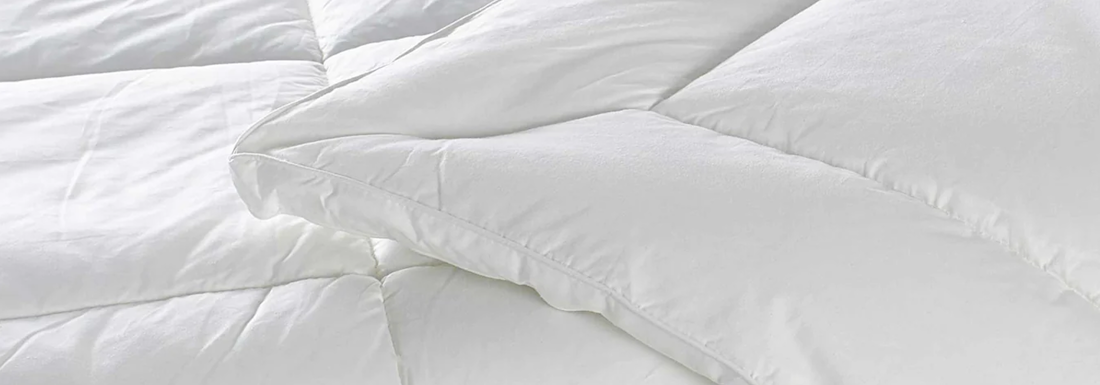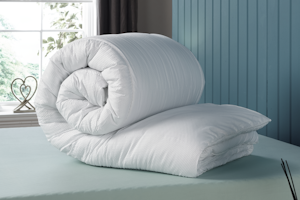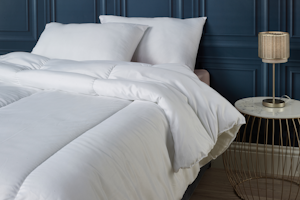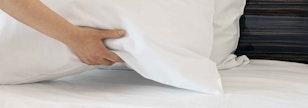20 Mar 2025

Which is the Best Filling for Duvets?
01 Aug 2024
The importance of a good duvet cannot be understated. Duvets make or break a sleeping experience, defining the comfort, warmth and general feel of the overall bed. And, with so many options available, choosing the best duvet filling can be a bewildering process. Don’t fret - in this guide, we’ll explain everything you need to consider when deciding which duvet filling is best for you.
In general, the best synthetic filling for duvets is microdown, whereas the best natural duvet filling is goose down. However, beyond the filling material, there are several other factors to consider when choosing the perfect duvet. You must also consider the fill power, tog rating, size, and allergy-friendliness of the duvet’s filling; all of these aspects will influence the suitability of the duvet as per your personal preferences and requirements.
What Are the Different Types of Fillings in Duvets?
Broadly speaking, there are two main categories that duvet fillings fall under; either synthetic fillings or natural fillings. Synthetic duvet fillings include microfibre and hollowfibre, whereas natural fillings can be feather, down, silk, or wool. We discuss each of these different duvet fillings in more detail below.
Synthetic Duvet Fillings
Synthetic duvet fillings are those made with non-organic substances, namely polyester, which is a type of plastic. Although lower-end cheaper duvets are often synthetic, having a synthetic filling doesn’t necessarily mean a duvet will be low-quality. A high-quality microfibre duvet would be the ideal choice for those seeking the next-best hypoallergenic alternative to natural fillings.
1. Microfibre Duvets
Microfibre duvets contain a filling made from fine fibres of polyester. The individual fibres are thinner than human hair, and soft and silky in texture. As a filling, microfibre is considered to be the synthetic equivalent of naturally sourced down. This filling is relatively cheap to manufacture on a mass-production basis, making the duvets more affordable than natural alternatives. A quality microfibre duvet can mimic the feel of a high-fill down duvet; however, low-quality microfibre duvets will lack the same degree of natural loft and breathability. All microfibre duvets are hypoallergenic.
2. Hollowfibre Duvets
Hollowfibre duvets also contain a polyester microfibre filling, with each individual fibre having a hollow core. This structure improves the insulating properties of the duvet’s filling; the core on each fibre traps warm air, emulating the natural way in which down works as an insulator. The hollowfibres are lightweight and firm, creating a durable filling that provides better warmth and breathability than regular microfibre. If opting for a synthetic duvet, hollowfibre is a great choice - we recommend our Essential Hollowfibre 10.5 Tog Duvet as a luxurious, all-purpose synthetic duvet at an inexpensive price.
3. Microdown or ‘Feels Like Down’ Duvets
More commonly named ‘feels like down’, microdown duvets are made from the finest threads of high-grade microfibre. Due to their ultra-fine threads, these duvets are the closest synthetic alternatives to natural down duvets. The microdown filling most accurately replicates the heat-retention and luxurious fluffiness of actual down; duvets with this filling are also much more affordable and completely hypo-allergenic. Our Luxury Feels Like Down 10.5 Tog Duvet is a popular choice for those in the hospitality sector and beyond seeking the next-best alternative to natural down.
Natural Duvet Fillings
Natural duvet fillings are made from entirely organic materials of animal origins, including duck, geese and sheep. These duvets are generally considered to be the highest-quality type of duvet available. Natural duvet fillings come with numerous natural properties that make them far superior to low-quality synthetic alternatives.
1. Feather Duvets
Duck feather and goose feather duvets contain feathers taken from the outermost coat of these birds. Feather duvets possess superior insulating properties than synthetic duvets, while also having better breathability and loft. However, compared to down duvets, feathers are slightly heavier and less breathable. Also, the individual feathers that make up the filling each have a hard quill; if the cover fabric isn’t robust enough, the feathers can escape the filling and poke through the duvet.
2. Down Duvets
Duck down and goose down duvets contain feathers taken from the soft undercoat of the origin birds. Down feathers have no form of a hard quill, instead being clusters of soft, fluffy filaments. The down clusters create air pockets that enable the filling to trap warm air; this results in a lightweight, lofty duvet that has excellent heat-retention properties. At the same time, down duvets are highly breathable, making them suitable for use all year round. Although they aren’t strictly hypoallergenic, down duvets can still be suitable for allergy sufferers; they don’t hold onto dust and other irritants like synthetic duvets can, and will respond well to machine washing. Due to these properties, down duvets are considered to be the utmost in comfort, quality and durability.
3. Feather and Down Combination Duvets
Feather and down duvets contain a combination of both types of plumage. These duvets combine the plumpness of a feather duvet with the softness and heat retention of a down duvet. As a result, you get the best of both fillings at a more affordable price than the costliness of a 100% down duvet. For example, our Luxury Goose Feather & Down 13.5 Tog Duvet is a long-lasting natural duvet with an ideal balance of both materials; it is luxuriously soft, highly insulating, and retains its original condition with daily plumping.
4. Silk Duvets
Silk duvets are less commonplace than other natural fillings. Still, as silk is naturally free of allergens, these duvets are a hypoallergenic alternative to down and feather. They are durable, lightweight and have good breathability and heat-regulating properties.
5. Wool Duvets
Wool duvets are another hypoallergenic alternative to feather and down duvets. Due to the dense structure of the filling, wool duvets effectively retain heat by trapping warmth and dry air; however, this density can make wool duvets feel heavy, unlike the comfortable envelopment that comes with a down duvet. Also, wool duvets have been known to give off somewhat of a ‘woolly’ odour.
What Else to Consider When Choosing the Best Duvet Filling
In addition to the filling type, there are some other important considerations to make when choosing the best duvet. You should also factor in the duvet’s fill power, tog rating, and size.
Fill Power of Duvet
Fill power is essentially a measure of the loft or fluffiness of a duvet’s filling, which reflects the filling’s insulating capacity. Another way to think of fill power is as the duvet’s warmth-to-weight ratio. In short, a higher fill power equates to a warmer, loftier duvet.
The more air chambers a filling has, the more insulating, lofty and breathable it will be. A greater number of air chambers will be represented as a higher fill power reflecting these various properties. In other words, the fill power is indicative of the filling’s effectiveness at keeping you warm; this figure also reflects the weight of the duvet, its durability, and its ability to recover its fullness after compression. For instance, high-quality down duvets typically come with higher fill powers as they require less filling to provide better insulation.
Fill power is either measured in grams per square meter (fgsm) or cubic inches per ounce (CUIN). To use the latter as an example, fill power in CUIN ranges from 450 to 900. A good fill power is one that measures 600 CUIN or above; anything lower than this will likely fail to provide adequate insulation.
Tog Rating of Duvet
Duvets also come with tog ratings, another measurement that reflects the degree of thermal insulation that the filling provides. Again, duvets with a higher tog rating will have better heat retentive properties.
If a duvet has a lower tog rating, it will trap less heat. And, vice versa, duvets with a higher tog rating will allow less heat to leak out. Keep in mind that tog ratings are not a marker of quality; you may find different tog ratings suitable for different times of the year based on the temperature. Some suggestions for the ideal tog ratings per season are as follows:
- Summer: It’s best to opt for a low tog rating in the warmer months, e.g. 4.5 tog. Duvets with this rating will be light and breathable, being particularly ideal for hot sleepers or those who suffer from night sweats.
- Autumn and Early Spring: During the milder months of autumn and early spring, a medium tog rating is most suitable, e.g. 10.5 tog. These duvets have sufficient heat retention to keep you warm without causing you to overheat.
- Winter: In the winter, a duvet with a high tog rating is best, e.g. 13.5 tog. This higher rating will most effectively trap heat to keep you warm and cosy when the external temperatures are low.
- All-Season: If you only want to invest in one duvet to use all year round, it’s best to choose a mid-range tog. Tog ratings from 7.5 to 10.5 should serve you well under both cool and warm temperatures.
Duvet Size
This is an obvious one, but you’ll have to pick the correct duvet size for the bed you’re dressing. In the UK, duvets and mattresses come in standard sizes, making this decision relatively straightforward. Refer to the table below for the standard duvet sizes and their equivalent mattresses:
|
Duvet Type |
Duvet Size |
Mattress Size |
|
Single Duvet |
135cm x 200cm |
90cm x 190cm |
|
Double Duvet |
200cm x 200cm |
135cm x 190cm |
|
King Size Duvet |
225cm x 220cm |
150cm x 200cm |
|
Super King Size Duvet |
260cm x 220cm |
180cm x 200cm |


